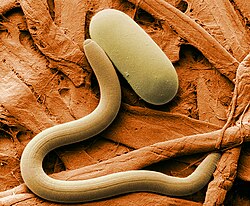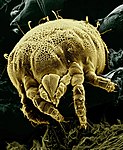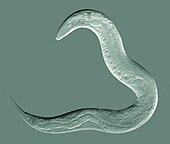Microfauna

Microfauna (Ancient Greek mikros "small" + Neo-Latin fauna "animal") refers to microscopic animals and organisms that exhibit animal-like qualities, and have body sizes that are usually <0.1mm.[1][2] Microfauna are represented in the animal kingdom (e.g. nematodes, small arthropods) and the protist kingdom (i.e. protozoans). A large amount of microfauna are soil microfauna which includes protists, rotifers, and nematodes. These types of animal-like protists are heterotrophic, largely feeding on bacteria. However, some microfauna can consume other things, making them detritivores, fungivores, or even predators.[3]
Habitat[edit]
Microfauna are present in every habitat on Earth. They fill essential roles as decomposers and food sources for lower trophic levels, and are necessary to drive processes within larger organisms. Populations of microfauna can reach up to ~107 (~10,000,000) individuals g−1 (0.1g, or 1/10th of a gram), and are very common in plant litter, surface soils, and water films.[3] Many microfauna inhabit soil habitats such as nematodes. Plant parasitic nematodes inhabit the roots of various plants, while free-living nematodes live in soil water films.[3]
Microfauna also inhabit freshwater ecosystems. For example, freshwater microfauna in Australia include rotifers, ostracods, copepods, and cladocerans.[4] Rotifers are filter feeders that are usually found in fresh water and water films. They consume a variety of things including bacteria, algae, plant cells, and organic material.[3]
Tardigrades inhabit a variety of lichens and mosses. They need water in these areas to allow for gas exchange and to prevent them from desiccating.[5] Because of this they are considered aquatic. However, they have also been found in all kinds of environments that range from the deep sea to dunes. Tardigrades are considered omnivores that have specialized mouths called bucco pharyngeal apparatuses which they use to consume different microorganisms and plants in their environments.[5]
Role[edit]

One particular example of the role of microfauna can be seen in soil, where they are important in the cycling of nutrients in ecosystems.[6] The ecological functions of the rhizosphere can be influenced by microfauna, specifically by nematodes and protozoa who are abundant in soil. For instance, the carbon cycling within the soil can be affected by nematodes who will feed on the roots of plants, impacting the organic carbon in the soil. Similarly, soil protozoa are able to release phosphorus and nitrogen into the soil and higher trophic levels by dissolving the organic material and nutrients available.[7]
Soil micro-fauna can also impact microorganisms within the rhizosphere by affecting their diversity and accelerating microorganism turnover. This happens because of the microfauna's selective grazing and their ability to influence the resources within the soil.[8] For example, protozoa can help maintain the quality of the soil by grazing on soil bacteria. Through their grazing, the protozoa can help maintain populations of bacteria, allowing the bacteria to more efficiently decompose dead organic material which will improve the fertility of the soil.[9]
Soil microfauna are capable of digesting just about any organic substance, and some inorganic substances.[citation needed] These organisms are often essential links in the food chain between primary producers and larger species. For example, zooplankton are widespread microscopic animals and protists that feed on algae and detritus in the ocean, such as foraminifera.
Microfauna also aid in digestion and other processes in larger organisms.
Cryptozoa[edit]
The microfauna are the least understood of soil life, due to their small size and great diversity. Many microfauna are members of the so-called cryptozoa, animals that remain undescribed by science. Out of the estimated 10-20 million animal species in the world, only 1.8 million have been given scientific names, and many of the remaining millions are likely microfauna, much of it from the tropics.
Phyla[edit]
Examples of notable phyla that include some microfauna:
- Microscopic arthropoda:
- Dermatophagoides, ("Dust mites")
- Tettranychidae, ("Spider mites")
- Some Crustacea, ("Crustaceans")
- Tardigrada, ("Water bears" or "moss piglets")
- Rotifera, ("Wheel animals")
- Nematoda, ("Roundworms")
- Loricifera, these are recently discovered anaerobic species, which spend their entire lives in an anoxic environment.[10][11]
- Microscopic Images of Microfauna
-
Rotifera (Habrotrocha rosa),type of rotifer only found in the leaves of Sarracenia purpurea
-
Tardigrade that was extracted from moss
-
Nematoda (Caenorhabditis elegans)
Similar Concepts[edit]
Macrofauna vs Microfauna[edit]
Macrofauna are organisms that are greater than 2mm in size that usually inhabit soft sediments.[12] They are also found in the benthic zone, and are suspension feeders or deposit feeders.[13] They are important to the marine food web as they are preyed upon by other organisms. Macrofauna, such as earthworms, are able to be separated into small parts through fragmentation, and are able to decompose organic matter.[14]

Microflora vs Microfauna[edit]
Microflora are organisms that reside within intestines and assist with the digestion of food.[15] In soil, there are three main groups of microflora: viruses, fungi, and bacteria.
See also[edit]
References[edit]
- ^ Dettwyler, Katherine A. (2011). Cultural anthropology & human experience : the feast of life. Long Grove, IL. ISBN 9781577666813. OCLC 706024344.
- ^ Fernández-Luqueño, Fabián; Vázquez-Núñez, Edgar; Pérez-Hernandez, Hermes (2023-01-01), La Rosa, Guadalupe De; Peralta-Videa, Jose R. (eds.), "Chapter 4 - Biophysicochemical transformations of ENMs in soil", Physicochemical Interactions of Engineered Nanoparticles and Plants, Nanomaterial-Plant Interactions, vol. 4, Academic Press, pp. 89–114, ISBN 978-0-323-90558-9, retrieved 2024-02-13
- ^ a b c d Haynes, Richard John (2014-01-01), Sparks, Donald (ed.), "Chapter Two - Nature of the Belowground Ecosystem and Its Development during Pedogenesis", Advances in Agronomy, vol. 127, Academic Press, pp. 43–109, doi:10.1016/b978-0-12-800131-8.00002-9, retrieved 2024-02-29
- ^ Walsh, Robert. "Australian Waterline" (PDF).
- ^ a b "Tardigrade". Animals. 2020-03-13. Retrieved 2024-03-25.
- ^ Aescht, E; Foissner, W (1996). "Microfauna". In Schinner, F; Öhlinger, R; Kandeler, E; Margesin, R (eds.). Methods in Soil Biology. Berlin, Heidelberg: Springer. doi:10.1007/978-3-642-60966-4_22.
- ^ Vaerewijck; Houf. "4 - The role of free-living protozoa in protecting foodborne pathogens". Woodhead Publishing Series in Food Science, Technology and Nutrition. 2: 81–101 – via Science Direct.
- ^ Chen, Xiaoyun; Liu, Manqiang; Hu, Feng; Mao, Xiaofang; Li, Huixin (2007-08-01). "Contributions of soil micro-fauna (protozoa and nematodes) to rhizosphere ecological functions". Acta Ecologica Sinica. 27 (8): 3132–3143. doi:10.1016/S1872-2032(07)60068-7. ISSN 1872-2032.
- ^ "Protozoan - Cell Structure, Nutrition, Reproduction | Britannica". www.britannica.com. Retrieved 2024-03-28.
- ^ Fang, Janet (6 April 2010). "Animals thrive without oxygen at sea bottom". Nature. 464 (7290): 825. doi:10.1038/464825b. PMID 20376121.
- ^ "Briny deep basin may be home to animals thriving without oxygen". Science News. 9 April 2010.
- ^ Heděnec, Petr; Jiménez, Juan Jose; Moradi, Jabbar; Domene, Xavier; Hackenberger, Davorka; Barot, Sebastien; Frossard, Aline; Oktaba, Lidia; Filser, Juliane; Kindlmann, Pavel; Frouz, Jan (2022-10-17). "Global distribution of soil fauna functional groups and their estimated litter consumption across biomes". Scientific Reports. 12: 17362. doi:10.1038/s41598-022-21563-z. ISSN 2045-2322. PMC 9576680. PMID 36253487.
- ^ Watling, Les (2019-01-01), Cochran, J. Kirk; Bokuniewicz, Henry J.; Yager, Patricia L. (eds.), "Macrofauna", Encyclopedia of Ocean Sciences (Third Edition), Oxford: Academic Press, pp. 728–734, ISBN 978-0-12-813082-7, retrieved 2024-03-01
- ^ Maurya, Anurag; Singh, Manoj Kumar; Kumar, Sushil (2020-01-01), Vara Prasad, Majeti Narasimha; Grobelak, Anna (eds.), "Chapter 7 - Biofiltration technique for removal of waterborne pathogens", Waterborne Pathogens, Butterworth-Heinemann, pp. 123–141, ISBN 978-0-12-818783-8, retrieved 2024-03-01
- ^ "National Cancer Institute". www.cancer.gov. 2011-02-02. Retrieved 2024-03-01.




